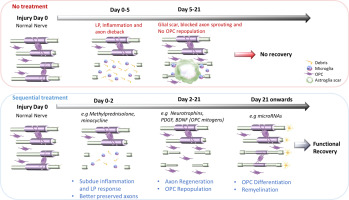Advanced Drug Delivery Reviews ( IF 16.1 ) Pub Date : 2019-03-22 , DOI: 10.1016/j.addr.2019.03.004 William Ong , Coline Pinese , Sing Yian Chew

|
Neural tissue regeneration following traumatic injuries is often subpar. As a result, the field of neural tissue engineering has evolved to find therapeutic interventions and has seen promising outcomes. However, robust nerve and myelin regeneration remain elusive. One possible reason may be the fact that tissue regeneration often follows a complex sequence of events in a temporally-controlled manner. Although several other fields of tissue engineering have begun to recognise the importance of delivering two or more biomolecules sequentially for more complete tissue regeneration, such serial delivery of biomolecules in neural tissue engineering remains limited. This review aims to highlight the need for sequential delivery to enhance nerve regeneration and remyelination after traumatic injuries in the central nervous system, using spinal cord injuries as an example. In addition, possible methods to attain temporally-controlled drug/gene delivery are also discussed for effective neural tissue regeneration.
中文翻译:

支架介导的顺序药物/基因递送促进神经外伤后的神经再生和髓鞘再生
创伤性损伤后的神经组织再生通常较差。结果,神经组织工程领域已经发展为寻找治疗性干预手段,并取得了可喜的成果。但是,健壮的神经和髓鞘再生仍然难以捉摸。一个可能的原因可能是这样的事实,即组织再生经常以时间控制的方式遵循一系列复杂的事件。尽管组织工程的其他几个领域已经开始认识到顺序递送两个或多个生物分子对于更完整的组织再生的重要性,但是在神经组织工程中这种生物分子的连续递送仍然受到限制。这篇评论的目的是强调需要在中枢神经系统创伤后顺序分娩以增强神经再生和髓鞘再生,以脊髓损伤为例。另外,还讨论了获得时间控制的药物/基因递送的可能方法,以进行有效的神经组织再生。


























 京公网安备 11010802027423号
京公网安备 11010802027423号